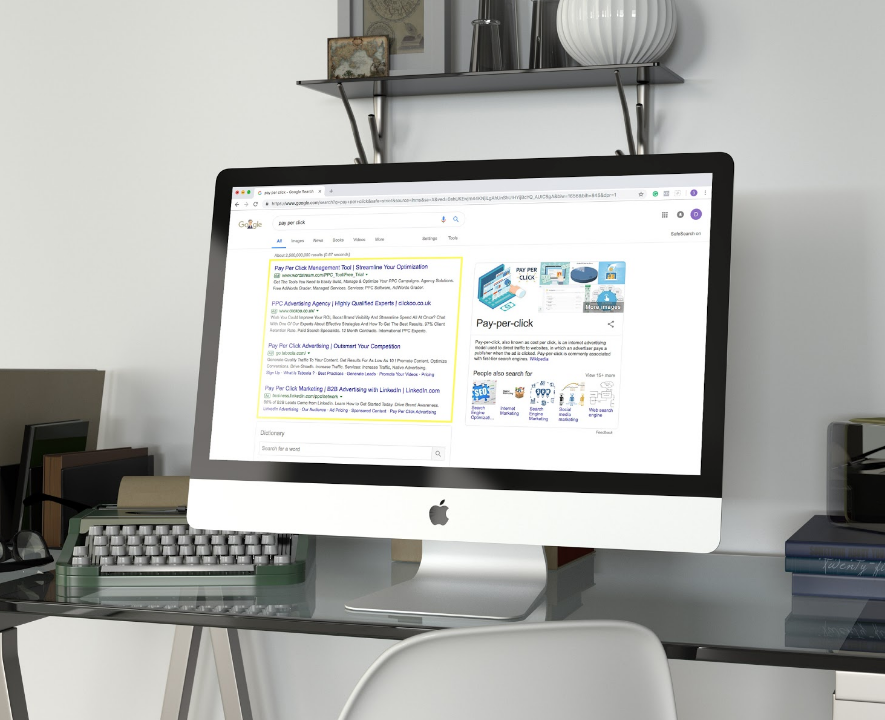
So before we get going, I just wanted to flag a little warning that the things we’re going to cover in this post (so SEO and Digital Advertising), will only work if your product, service and website is up to scratch and engaging.
I’ve had many clients come to me in the past and ask for me to drive traffic to their websites, which is fine, but if those visitors don’t then go and engage with the business, contact them, or make a sale, then that’s pretty pointless, right?
So making your website clear first is really key.
And why’s that? Well because it takes just 0.05 seconds for visitors to form an opinion about your website and decide if they’re going to stay, or leave. Which really isn’t long to impress.
The fact that 88% of online consumers are less likely to return to a website after a bad experience is another reason to get this spot on first.
OK so once you’ve got that right that, where should you focus your efforts? Well it really depends what you’re trying to achieve, and this graphic from SEM Rush explains it really nicely.
If you’re looking to get more people to your website quickly, then pay per click (PPC) advertising (that could be Google ads or Facebook ads for example) might be the way to go. But as you can see, as soon as you stop that activity, your website traffic will simply drop back down.
And this is why it’s important to always have a longer term plan for growing your audience and business. So here for example you can see that creating great social media content, or generating good PR for your business, are a good way of getting more visitors over the medium term.
But the long-term plan, which will lead nicely onto my first tip, is always great website content, that is well optimised from an SEO perspective. Now yes this is a long-term plan, and takes 6-12 months to really start seeing the benefit, but it’s essential for future proofing your business long-term and ensuring you have customers not just now, but in the future too.
OK onto the tips, and first up, one you’ll have no doubt heard many times, but as far as getting your website found these days? Content really is king.
TIP 1. Create great content, but make it relatable.
And by that I mean it can be really surprising, but sometimes, even the most basic of topics or products can be hot news. None less than right now.
If you can create content that’s unique, fresh, and helpful for users, then Google will rank it higher on its search engine page results. Google pays special attention to your content quality. No matter how optimized your website is, if your content is not valuable, then you can’t expect higher rankings.
See here for example, these are a few terms I searched in Google Trends to see how many people were searching for them, and you can see the spikes in interest around these products these past weeks.
Now yes these topics might be dry topics to do a blog post on… but for small business owners for example, I could easily write an article including a couple of these. Say ‘5 top tips for small business owners during lockdown’:
- Tip 1) Inform your staff about the process for applying for a mortgage holiday, and saving money
- Tip 2) Customers can’t come to you, but why not work with a local taxi firm to organise home deliveries
- Tip 3) Prepare for going back to the office; order essential supplies now whilst they’re available
OK so there are a few tenuous ones in there, but there’s a really current, relevant blog article that people might just stumble across through related searches right now.
Tip 2. Make sure your website is fast
Now Google has around 200 ranking factors for whether they are going to show your website for particular searches, and one of the key ones of those, is your page speeds.
Google wants your website to load quickly and provide a great user experience for your audience.
Google page speed insights is one great way of doing this; it’s quick, free, easy to understand, and will provide you a detailed report showing just how fast your website is loading across desktop and mobile devices, along with a ‘fix list’ for improving your score in the future.
Tip 3. Don’t obsess with desktop. Get your mobile optimisation on point.
Along with speed, another thing to look at is whether your site mobile friendly or not.
Ever since Google has gone mobile-first in 2019, its key that your website is mobile responsive. Mobile-first means that Google will now use your website’s mobile version for indexing and ranking.
Previously, Google would use your desktop as the primary version for indexing. But with 3.7 billion mobile internet users in the world, it’s no surprise that Google has made this shift.
So, if you want to boost your rankings, now is the best time to make your website mobile-friendly.
Tip 4. Structure, layout and purpose is more important than design.
Tip 4 is that structure, layout and purpose is more important than design. And I can use a good friends websites to show this nicely.
So this is the PE Shed, a website built on Wix (a platform notoriously tough from an SEO perspective) and one that proves perfectly that spending a fortune on a fancy website design isn’t everything. This website gets a lot of traffic simply because:
✓ PE teachers struggle for lesson ideas; it has a purpose.
✓ It splits resources by seasons, times of year and sport; it has a reason for people to look around.
✓ The ‘basic’ resources are free (the hook) but the better resources are paid for; it has a reason for people to buy.
✓ Teachers need to change their lessons every term; it has a reason for them to come back.
And here are some google searches for the key search queries the website wants to show for:
- PE games
- Physical education games
- PE warm ups
And you can see here that he is showing in the top 1-3 positions for these terms. And because of this? He achieves over 10,000 website visitors per month. Which is really impressive.
Get your structure, layout, purpose and basic SEO right? And you could be onto a winner.
Tip 5. Google search console. The must have tool for every website.
Tip 5 is simply to make sure that your website has Google Search Console installed.
I’m amazed at the amount of client’s websites that have been set up by marketing agencies, yet DONT have google search console set up, and it’s really important. It’s a quick and easy way that informs you via email directly how to:
- Fix any errors or bugs
- See which other websites link to your website
- Find out search queries users use to find your business
- Submit a sitemap (and much, much more)
And this is just an example of what you see when you login to Google search console.
Here I’ve shown a clients information, so how many times Google is showing their website in search engine results (which is called impressions), and the number of clicks to their website from those searches (total clicks).
And here it shows how those numbers have improved since we’ve been working on the SEO the past 6 months. With impressions doubling, and clicks around 40% up too.
You can learn so much using this tool, and it’s real validation to see the fruits of all of your SEO labour.
Tip 6. Backlinks are essential. No backlinks? No traffic.
Tip 6 is that backlinks to your website are really important. If you don’t have any, you’ll really struggle to get website visitors.
SO first up, what is a ‘backlink’ – A backlink is simply a link from one website to another. Search engines like Google use backlinks as a ranking signal because when one website links to another it proves to them the content is credible. And really, after content, it’s the second most important Google ranking factor.
In fact, content and backlinks go hand in hand, as web pages without any backlinks hardly get any organic traffic whatsoever…
Backlinks or inbound links are like a vote of confidence for your website. Google adds all those votes together and checks if your website deserves to rank in the top 10 results.
If you can get backlinks from high authority websites, you can boost your chances of higher rankings. That’s because by acquiring these links, you’re sending a signal to Google that your content is trustworthy as different websites can vouch for it.
But how do you do that?
Well firstly, START BY LINKING YOURSELF.
Don’t wait for other people to link to your website…
Adding links to 5-8 credible websites per article will really help. Linking to trusted websites shows Google your content is well-referenced / trustworthy too.
And secondly, why not have a go at spying on Your Competitors!
Ever wonder where your competitors get their backlinks from?
You can (quite ethically thankfully) spy on your competitors to find sources for backlinks, look at their organic keywords, top-performing content, social media activities, and more.
To look for backlinks, you can use tools like SEM Rush, which provide a backlink profile of any website address that you enter.
AHRefs also offers great features to see where your competitors are getting their traffic from too.
And the benefit of this is that if these websites are linking to your competitors, chances are they’ll be happy linking to yours too.
So simply sending them a nice personal email with a link to your latest blog post, could well end up in you gaining your first link to that page.
Tip 7. If you’re advertising, try remarketing.
Remarketing you can do through Google or Facebook ads, but why bother? Because on average only 2% of website visitors convert on their first trip to a given site, so you need a way to bring back that lost 98%.
So how does it work? Well you’re essentially putting adverts in front of people that are already interested in your business.
So when a person visits your website, they are then tracked by a cookie on your website. When the person then leaves your website, your adverts will then serve to those people, encouraging them to come back and complete their purchase, contact form etc.
You can even set the frequency / max no. of times people see your ad, before you stop showing it to them; so you don’t waste money on the same person over and over.
And because the people you’re targeting are already aware business, they’re much more likely to convert to a customer or sale.
Tip 8. Get the SEO basics right.
So just to cover the basics of SEO, and SEO is based around keywords. Keywords are essentially the words or terms users use to look up things on Google.
So, it’s important that your website contains the keywords your audience is searching for. That way, Google can obviously bring up your website in its search results.
To ensure that your website is keyword optimized, you can use handy plugins to guide you along the way, so if your website is on WordPress for example, then make sure you’re using the Yoast plugin to help you get every page or blog post in a good place. It’ll help you to improve your:
- Title Tags – by including your target keyword at the start of your posts
- Meta Descriptions – essentially the short elevator pitch so users know what your page is about and click on it.
- Image Alt Text – Since Google cannot read images, you can add your keywords in the alt text section to explain what the image is about.
- Add Keywords in URL – Another keyword optimization practice is to include your keyword in the URL of your post.
So all these things are just as important as the content on the page itself. Otherwise? Google will simply struggle to read the page, and won’t show it in the search results pages.
And remember that up to 92% of search engine searches don’t go further than page 1 on Google… so ensuring your business can be found, and easily, is essential.
Tip 9. If you’re going to advertise. Now’s the time to try it.
Online ads at the moment are 30-40% cheaper than they were a few months ago (before Covid-19), mainly due to the fact there is less competition out there now! With less people advertising.
So whether you’re considering Google Ads, Facebook Ads or another platform? It’s a great time to try it.
Tip 10. Give Google Shopping & Facebook Shops a try.
And finally on the topic of advertising, if you have a product that you sell, then shopping ads are well worth looking into.
Shopping ads are the ads you see at the top of the page with the products in a nice carousel.
They are generally cheaper than search ads (around ⅓ of the cost) but drive 76% of retail search ad spend now which is a huge amount.
And on mobile well you can see that shopping now takes up not most of, but the WHOLE page when you land on it. So naturally click through rates are increasing all the time, and shoppers aren’t even making it to the usual text ads anymore…
It’s also worth noting that Google express is growing, which is Google’s attempt to take back some product searches from Amazon. It’s basically google shopping but on a page where you can filter by product type, brand, size etc – and show you the best places to buy the product from based on that criteria.
And as of very recently, is Facebook’s announcement that they’re launching ‘Shops’.
The initial stage of the Facebook Shops rollout has been brought forward and extended because of Covid-19 in an attempt for Facebook to help small businesses with their sales during this time.
The stores will appear on business pages, Instagram profiles and through targeted ads, and enables users to buy products directly through Facebook or Instagram, rather than having to leave the platform to complete the purchase.
And with 2 billion users to target? It’s definitely worth looking in to…
If you have any tools that make a real difference to your business, then let us know in the comments box below so that we can make sure we check it out. Or get in touch to have a chat about how we can help you with your digital marketing needs.





Recent Comments